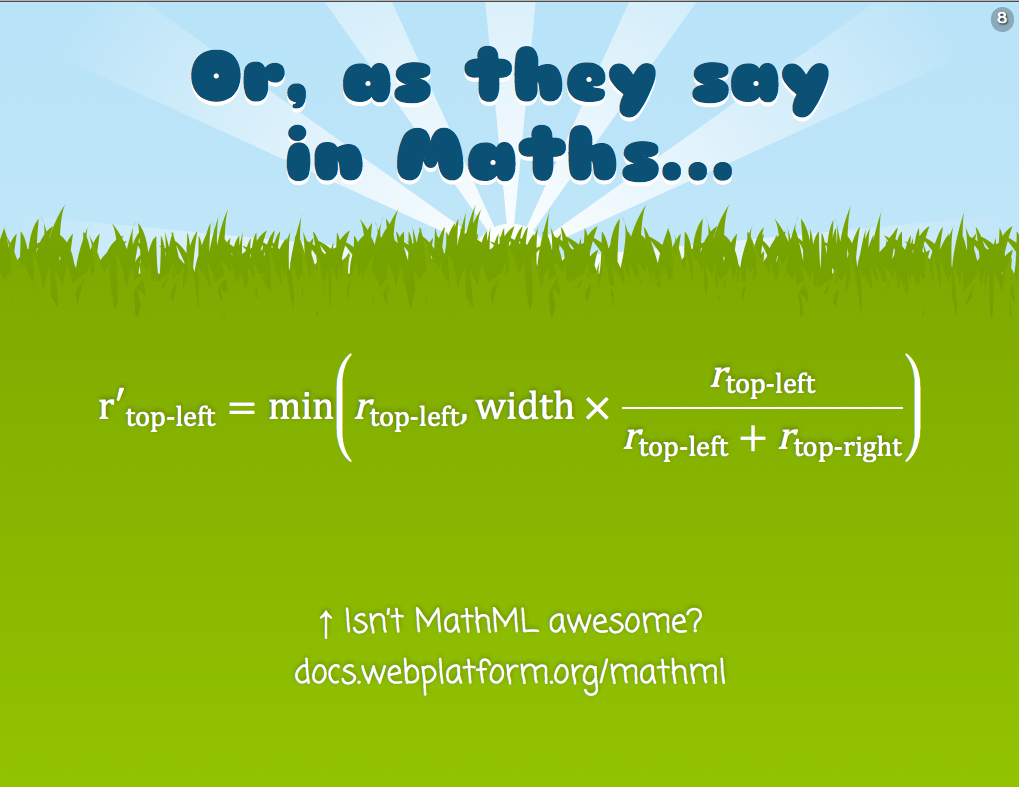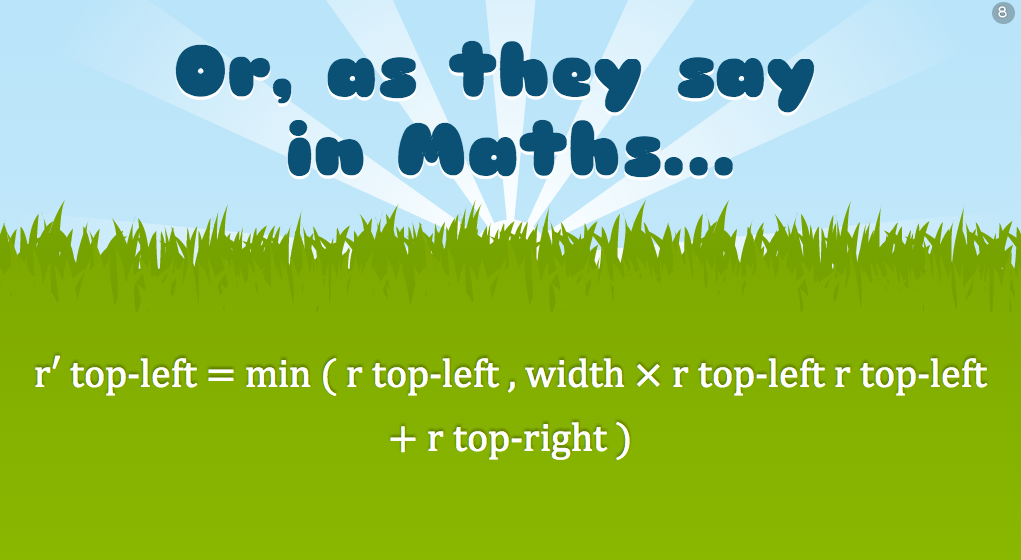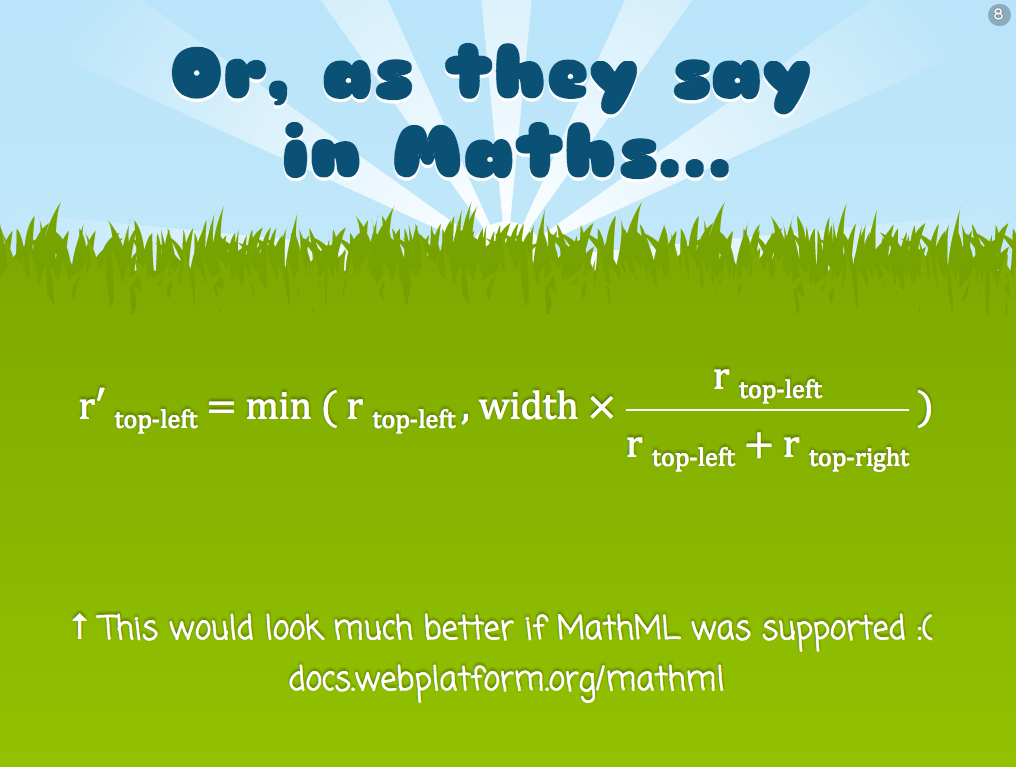These days, I’m working on the slides for my next talk, “The humble border-radius”. It will be about how much work is put into CSS features that superficially look as simple as border-radius, as well as what advances are in store for it in CSS Backgrounds & Borders 4 (of which I’m an editor). It will be fantastic and you should come, but this post is not about my talk.
As you may know, my slides are made with HTML, CSS & JavaScript. At some point, I wanted to insert an equation to show how border-top-left-radius (as an example) shrinks proportionally when the sum of radii on the top side exceeds the width of the element. I don’t like LaTeX because it produces bitmap images that don’t scale and is inaccessible. The obvious open standard to use was MathML, and it can even be directly embedded in HTML5 without all the XML cruft, just like SVG. I had never written MathML before, but after a bit of reading and poking around existing samples, I managed to write the following MathML code:
<math display="block">
<mrow>
<msub>
<mi>r′</mi>
<mi>top-left</mi>
</msub>
<mo>=</mo>
<mi>min</mi>
<mo>(</mo>
<msub>
<mi>r</mi>
<mrow>
<mi>top-left</mi>
</mrow>
</msub>
<mo>,</mo>
<mi>width</mi>
<mo>×</mo>
<mfrac>
<mrow>
<msub>
<mi>r</mi>
<mi>top-left</mi>
</msub>
</mrow>
<mrow>
<msub>
<mi>r</mi>
<mi>top-left</mi>
</msub>
<mo>+</mo>
<msub>
<mi>r</mi>
<mi>top-right</mi>
</msub>
</mrow>
</mfrac>
<mo>)</mo>
</mrow>
</math>
I was very proud of myself. My first MathML equation! It’s actually pretty simple when you get the hang of it: <mi> is for identifiers, <mo> for operators and those are used everywhere. For more complex stuff, there’s <mfrac> for fractions (along with <mrow> to denote the rows), <msqrt> for square roots and so on.
It looked very nice on Firefox, especially after I applied Cambria Math to it instead of the default Times-ish font:
However, I soon realized that as awesome as MathML might be, not not all browsers had seen the light. IE10 and Chrome are the most notable offenders. It looked like an unreadable mess in Chrome:
There are libraries to make it work cross-browser, the most popular of which is MathJax. However, this was pretty big for my needs, I just wanted one simple equation in one goddamn slide. It would be like using a chainsaw to cut a slice of bread!
The solution I decided to go with was to use Modernizr to detect MathML support, since apparently it’s not simple at all. Then, I used the .no-mathml class in conjunction with selectors that target the MathML elements, to mimic proper styling with simple CSS. It’s not a complete CSS library by any means, I just covered what I needed for that particular equation and tried to write it in a generic way, so that if I need it in future equations, I only have to add rules. Here’s a screenshot of the result in Chrome:
It doesn’t look as good as Firefox, but it’s decent. You can see the CSS rules I used in the following Dabblet:
Obviously it’s not a complete MathML-to-CSS library, if one is even possible, but it works well for my use case. If I have to use more MathML features, I’d write more CSS rules. The intention of this post is not to provide a CSS framework to use as a MathML fallback, but to show you a solution you could adapt to your needs. Hope it helps!


